Osteoarthritis of the hip joint, also called coxarthrosis, is one of the most serious diseases of a modern person, often resulting in disability. Its first manifestations - a slight pain in the groin - are usually ignored. As a rule, the patient seeks qualified medical help when drug therapy is ineffective and stents are required.
Reasons
Osteoarthritis of the hip joint is caused by a combination of various adverse circumstances. Strain injuries and full-fledged injuries account for about one-fifth of the total number of patients (on average 10-20%).
Other causes of osteoarthritis of the hip include:
- Excessive loads.
- Heart attack or aseptic necrosis of the hip joint.
- Prolonged stress, prolonged depression.
- Overweight.
- Heredity.
- Congenital anomalies and underdevelopment.
- Inflammatory processes in the joints.
- Hormonal background failure.
Excessive loads

Until recently, it was believed that excessive physical exertion, many hours of walking, hard work (as a charger) was the main cause of osteoarthritis. But this is not the case.
A healthy joint that has never been injured perfectly tolerates stress, especially at a young age, and nothing happens to it.
But if once, even in childhood, there was microtrauma, then such a joint is a candidate for the development of coxarthrosis. For this reason, the disease occurs in 20-30% of cases.
Heart attack
This is a violation of the blood flow in the joint. In other words, the disease is called aseptic necrosis of the hip joint, which usually occurs after injury.
Besides injury, the cause of a heart attack can be:
- Excessive alcohol consumption.
- Frequent corticosteroid injections.
- Unexpected shock (severe stress).
- Excessive one-off charges at a time when a person is not ready for them.
Heart attack becomes one of the causes of morbidity from coxarthrosis quite often - in 10-30% of cases.
Persistent stress
Few people believe in psychosomatics. However, prolonged experiences, depression, lack of understanding in the family and various phobias that arise in this context are a direct route to joint problems, and not just the hip. The incidence of osteoarthritis for this reason is very high - up to 50.
The mechanism of disease initiation in this situation is simple. During prolonged depression, the patient's body produces stress hormones which belong to the group of corticosteroids. The longer a person is in this state, the higher its concentration in the blood. Corticosteroids inhibit the production of hyaluronic acid, which is the main component of joint fluid. If it is not sufficiently produced or if its composition is changed, the cartilage is poorly moistened, dry, covered with a mesh of tiny cracks.
The stress hormone reduces capillary permeability while impairing blood flow in the joints.
Overweight
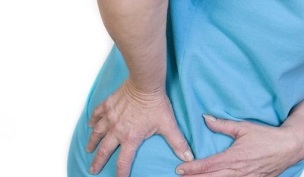
Is an additional factor among other causes of osteoarthritis of the hip joint (coxarthrosis).
Overweight people put enormous stress on their joints, especially the ankles, knees and hips.
As long as they are young, everything seems to work within normal limits. But with age, staying at the same weight, joint problems will develop like a snowball.
Heredity
If a loved one has had osteoarthritis, you don't have to get sick at all. However, the appearance of "sores" is influenced by the peculiarities of metabolism, the structure of cartilage and they can be inherited. It also includes the weakness of the muscular apparatus. For this reason, coxarthrosis can only be won in 10% of cases. And this is far from being the case. The main thing is to have regular check-ups and monitor the condition of your joints.
Congenital anomaly
This is usually dealt with in early childhood, allowing the child to grow and use the limb normally. However, the presence of an abnormality is always a risk of hip osteoarthritis, especially if you do not monitor the condition of your joints. The incidence rate is low - only 5. It should be remembered that only a set of several reasons leads to the occurrence of osteoarthritis of the hip joint.
Joint inflammation
This process is commonly referred to as arthritis. The disease causes the occurrence of secondary osteoarthritis in 2-3% of cases. The inflammatory process changes the quality of intra-articular fluid. It becomes more viscous and ceases to perform its direct functions. As a result, the cartilage rubs against the cartilage, gradually collapsing.
Among other reasons, directly or indirectly affecting the occurrence of coxarthrosis, one can cite hormonal changes of menopause, metabolic diseases (diabetes), nervous diseases (in which the sensitivity of the lower limbs is lost), osteoporosis.
Symptoms
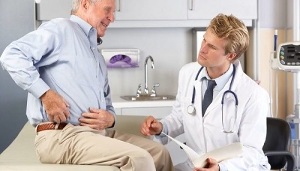
Osteoarthritis of the hip joint manifests itself in different ways. At the first stage of the development of the patient's pathology, almost nothing bothers, except for weak unpleasant, sometimes painful sensations, passing independently.
The symptoms of osteoarthritis of the hip joint are specific and allow a preliminary conclusion (to make a diagnosis) already at the stage of the examination:
- Pain in the groin. It is the main symptom of the disease. If you feel during movement that something is wrong with this area, try to see a doctor as soon as possible. Groin pain typically spreads along the front or side of the thigh and may radiate to the buttock or knee. It is extremely rare for pain in osteoarthritis of the hip joint to reach the middle of the calf muscle. The patient feels discomfort when sinking in a chair or getting up, or after a long walk.
- Restricted mobility. This symptom indicates that osteoarthritis of the hip joint (coxarthrosis) is already progressing. If you ask such a patient to sit "astride a chair", that is, upside down, it is unlikely that he will be able to do so.
- Crunch of the hip joint when walking. It does not appear immediately, but as the arthritis progresses and the cartilage is destroyed. Its difference from the usual tightening of a healthy joint is a rather dry sound and pain syndrome of low or moderate intensity.
- Shortening of the diseased limb. Occurs when the disease is already sufficiently advanced.
- Lameness, falling on a sore leg due to partial or complete destruction of the cartilage.
- Muscle atrophy of the affected leg. It visually looks dry and unhealthy.
- Pain in the knee joint due to muscle atrophy.
Diagnostics
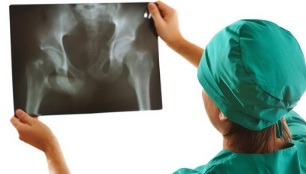
This time is not too long for the patient. After a visual examination and questioning of the patient, the doctor prescribes a referral for blood donation - a general analysis, biochemistry and a rheumatic test. This is done in order to exclude the inflammatory process in the body. With osteoarthritis, all indicators are close to normal.
The next step is the instrumental exams:
- Radiography and / or CT.The CT scan shows the joints a little better.
- IRM. Appointed first. Such a survey is as informative as it gets.
- Ultrasound of the joints.A sign of hip osteoarthritis in this study is a clear thinning of the cartilage. However, the accuracy of the result largely depends on the skills of the specialist deciphering the data obtained. Therefore, to establish the disease, it is prescribed in rare cases.
Consequences
If osteoarthritis of the hip joint is left untreated, hoping that "maybe it will go away on its own", the disease will actively progress. The consequences of such indifference to oneself are expressed in muscle atrophy and a clear shortening and drying out of the diseased limb, at some point a person will not be able to move independently. Pain syndrome will become a constant companion of such a patient; even strong pain relievers cannot relieve it. The only way out of this situation will be joint replacement surgery - stents.
If hip osteoarthritis is diagnosed in an elderly patient, treatment should be started immediately. A sedentary lifestyle, which invariably occurs in a patient due to constant and severe pain, significantly shortens life.
Traditional treatment
It can be divided into medicinal and surgical. The second is used in the event that the first does not bring significant improvement with prolonged use.

Coxarthrosis in the initial stages is quite treatable:
- Drugs.
- Manual therapy.
- Traction on a special table.
- Use of PIR (post-measurement relaxation).
- Therapeutic massage.
- Hirudotherapy.
- Catch-up gymnastics.
Drugs
The task of drugs is manifold. Not only tablets are used, but also ointments, intra-articular injections. Tablets (capsules, sachets) are prescribed to relieve pain (nonsteroidal anti-inflammatory drugs), improve the nutrition of cartilage and improve the quality of intra-articular lubrication (chondroprotectors), relieve muscle spasms (muscle relaxants).
Ointments and creams have the weakest effect and are used to warm and irritate. Their effect is close to placebo. At the time of rubbing, the patient's body produces endorphins - pleasure hormones, and they are quite effective in relieving pain.
Intra-articular injections for osteoarthritis of the hip are very rare. This is due to the narrow joint space, which it is quite difficult to enter, even with the use of special auxiliary equipment. The procedure is done through the groin and is so complex that ninety-nine percent of doctors prefer to inject the drug into the periarticular sac by making a puncture on the side of the thigh.
By injection:
- Relieves high intensity pain syndrome (corticosteroids).
- They nourish the cartilage (chondroprotectors).
- Improves the quality of the lubricant (hyaluronic acid substitutes - injected through the groin).
Nonsteroidal anti-inflammatory drugs are taken by mouth for mild to moderate pain. They also effectively extinguish inflammatory processes.
Manual therapy
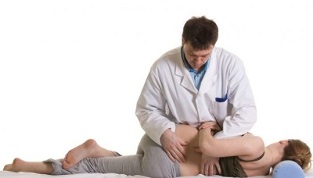
Treatment by an experienced specialist can put patients with moderate coxarthrosis back on their feet. The task of the doctor is to restore the mobility of the joint, to relieve pain. Manual therapy is subdivided into manipulation (only one effect on the joint) and mobilization (4 courses per year, 3 to 4 sessions each).
Mobilization allows you to stretch the affected limb with minimal pain. Enlarge joint space, relax tense muscles. Manipulation is allowed only in the early stages of the disease.
Traction on a special table also gives some results, but loses considerably in favor of manual therapy. The machine (device), unlike the doctor's hands, does not smell the patient and, if used incorrectly, may cause damage.
PIR
Post-isometric relaxation involves active interaction between the patient and the attending physician. The meaning of the method is that the patient relaxes / solicits certain muscle groups as directed by a specialist. At this point, the doctor stretches his ligaments and joints.
This treatment for hip osteoarthritis helps relieve muscle spasms. The method is effective for coxarthrosis of degrees I and II.
Massage
If you decide to use this method, you need to find a highly qualified specialist. Otherwise, instead of alleviating the condition, you can make it worse. The method is effective for I and II degrees of hip osteoarthritis as an auxiliary.
Massage for hip osteoarthritis should not cause pain. The sensations during the procedure are pleasant, relaxation and comfort should be felt.
Please note that there are contraindications to massage. Don't heal yourself.
Hirudotherapy
Treatment with leeches helps in the early stages of osteoarthritis of the hip joints. The saliva of this worm improves blood circulation, the elasticity of cartilage, and itself contains many useful substances. It acts as a chondroprotector, but milder.
Leeches are placed not only on the sore thigh, but also on the sacrum, lower abdomen and lower back. You must take 2 courses of 10 sessions per year.
Catch-up gymnastics
No disease can be cured or relieved without a dose of physical exercise. Osteoarthritis of the hip joint is no exception. If you do not strengthen the muscles, their atrophy is inevitable, while the condition of the cartilage will deteriorate at a double rate.
It is best to study in special groups under the supervision of specialists. The medical complex is selected by a doctor depending on the examinations, the degree of coxarthrosis and the physical capabilities of the patient.
Endoprostheses
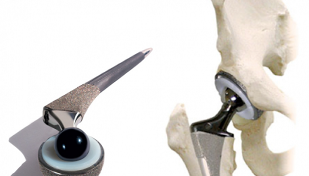
Surgical intervention is carried out in degrees III and IV of coxarthrosis, when conservative treatment gives minimal results or is not at all effective. The surgeon's task is to replace both the joint head itself and the acetabulum with artificial implants through a small incision in the thigh.
These operations are now in progress. To imagine what to expect if you ignore the first signs of hip osteoarthritis, imagine how the operation would go (in brief):
- The patient is anesthetized.
- An incision is made on the thigh, soft tissue is excised, nerves are pushed back.
- The joint is removed from its bed. Simply put, the doctor does an artificial dislocation to get his head back.
- The head of the joint with part of the bone is removed.
- The acetabulum is cleaned.
- An endoprosthesis, an artificial joint head, is inserted into the bone, or rather "plugged".
- An artificial acetabulum is inserted.
- The joint is repositioned. The doctor checks his mobility by moving the limb in different directions.
- The wound is disinfected and sewn up.
After the operation, a rather long period of rehabilitation and adherence to a certain diet is necessary.
Traditional methods
For fans of self-medication, note that hip osteoarthritis is a disease that should only be treated by a doctor. All the traditional methods in the form of rubs, lotions and other “unusual things” will do no good.
However, some recipes of traditional medicine can be used as a first-degree auxiliary of the disease:
- Cabbage leaves.Used to relieve pain without taking pain relievers and to relieve "twisting" of a painful joint. At night, attach a few cabbage leaves to your thigh, after rubbing pure honey on the skin. Wrap it with plastic wrap and something warm. Remove the honey in the morning, rinse with cold water and repeat the compress. Repeat until the pain subsides.
- Honey and turnip ointment.Similar in action to cabbage leaves. You just have to DIY to cook it. The turnip and honey ratio is 1/1. Twist the root vegetable in a meat grinder, add honey, stir. Pour 50 ml of vodka or alcohol. Stir again. Rub into the affected joint until the pain subsides.
- Healing baths.For cooking you need pine branches (a few large branches), turpentine (1 teaspoon), bath salt (1 kg) and washed Jerusalem artichoke tubers cut into pieces (3-4parts). Pour with hot water and let infuse. When the water is pleasant to take a bath, remove the branches and Jerusalem artichoke and begin the procedure. When finished, apply a dash of iodine to the painful thigh or rub it with honey, put on something warm and go to bed.
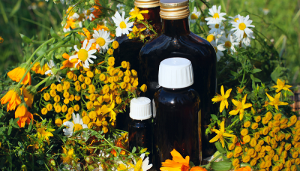
Osteoarthritis of the hip joint is a serious disease that occurs when several causes are combined.
In order not to become disabled, do not wait for the consequences, have annual examinations, at the first feeling of discomfort in the groin area, consult a doctor.



































